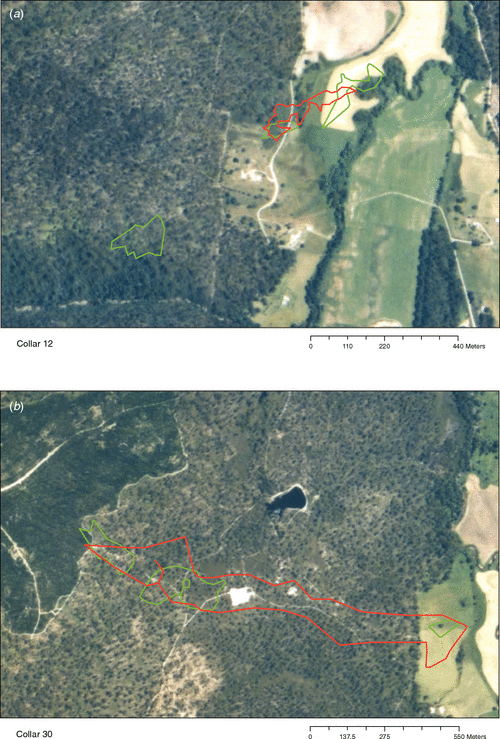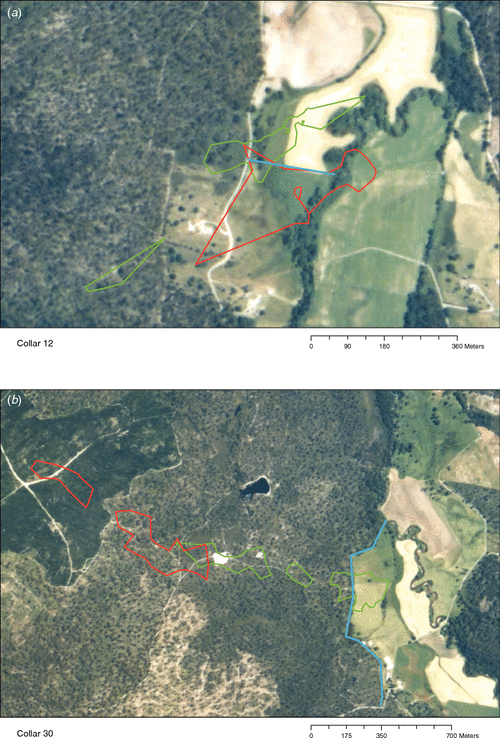Shifts in macropod home ranges in response to wildlife management interventions
Natasha L. Wiggins A B E , Grant J. Williamson A , Hamish I. McCallum B D , Clive R. McMahon C and David M. J. S. Bowman AA School of Plant Science, University of Tasmania, Private Bag 55, Hobart, Tas. 7001, Australia.
B School of Zoology, University of Tasmania, Hobart, Tas. 7001, Australia.
C School for Environmental Research, Institute of Advanced Studies, Charles Darwin University, Darwin, NT 0909, Australia.
D Present address: Griffith School of Environment, Griffith University, Brisbane, Qld 4111, Australia.
E Corresponding author. Email: wigginsn@utas.edu.au
Wildlife Research 37(5) 379-391 https://doi.org/10.1071/WR09144
Submitted: 26 October 2009 Accepted: 31 May 2010 Published: 11 August 2010
Abstract
Context. Understanding how the individual movement patterns and dispersion of a population change following wildlife management interventions is crucial for effective population management.
Aims. We quantified the impacts of two wildlife management strategies, a lethal intervention and a subsequent barrier intervention, on localised populations of the two most common macropod species in Tasmania, the Tasmanian pademelon (Thylogale billardierii) and the red-necked wallaby (Macropus rufogriseus rufogriseus). This manipulation allowed us to examine two competing hypotheses concerning the distribution of individuals in animal populations – the Ideal Free Distribution (IFD) hypothesis and the Rose Petal (RP) hypothesis. We predicted that the RP would be supported if individuals maintained their previous home ranges following intervention, whereas the IFD would be supported if individuals redistributed following the management interventions.
Methods. The movement patterns of T. billardierii and M. r. rufogriseus were tracked using GPS technology before and after the two management interventions.
Key results. Following lethal intervention, pademelons and wallabies (1) maintained their home-range area, (2) increased their utilisation of agricultural habitat and (3) shifted their mean centroid locations compared with the pre-intervention period. Following barrier intervention, pademelons and wallabies (1) maintained their home-range area, (2) decreased their utilisation of agricultural habitat and (3) shifted their mean centroid locations compared with the pre-intervention period.
Conclusions. On the basis of the individual responses of macropods to the management strategies (1) lethal intervention appeared to induce small shifts in home-range distributions of those remaining individuals in the population with home ranges overlapping the areas of lethal intervention and (2) barrier intervention is likely to induce whole-scale population movements of the animals that survive the lethal intervention in their search of an alternative food source. Both species displayed spatial and temporal shifts in their home-range distributions in response to lethal and barrier interventions that appear to conform broadly to predictions of IFD, at least in the timeframe of the present experiment.
Implications. Wildlife management strategies, which are increasingly constrained by ethical, socio-political and financial considerations, should be based on ecological and behavioural data regarding the likely responses of the target population.
Additional keywords: behaviour, centroid location, habitat use, home-range area, movement patterns, Tasmanian pademelon, red-necked wallaby, wildlife intervention.
Acknowledgements
The authors thank the Tasmanian Community Forest Agreement: Alternatives to 1080 Program for project funding, and the University of Tasmania for in-kind project support. Greg Blackwell of the Alternatives to 1080 Program, DPIPWE, provided invaluable knowledge and assistance with animal trapping, collaring and tracking. Garth Bennett and staff at Forestry Tasmania provided in-kind support and assistance with animal trapping. Dr Ivo Edwards provided trapping equipment. John Evans, Jo McMillan and Scott Nicols provided invaluable technical and field support. Dr Mick Statham and Helen Statham provided advice for fencing design. Clare Brooker and Amelia Fowles provided field assistance. David Wilson provided GIS support. Dr Michael Perring provided additional statistical support and manuscript comments. The authors thank Trevor Hall and Barry Whiting for the use of their land. Approval for research was granted by the University of Tasmania Animal Ethics Committee (Permit # A9895) and the Parks and Wildlife Service (Permit # FA08122).
Arnold, G. W. , and Steven, D. E. (1988). Variations in distribution of western grey kangaroos, Macropus fuliginosus ocydromus, in the Tutanning Nature Reserve and their impact on adjacent farmland. Wildlife Research 15, 119–128.
| Crossref | GoogleScholarGoogle Scholar |
Bulinski, J. (2000). Relationships between herbivore abundance and browsing damage in Tasmanian eucalypt plantations. Australian Forestry 63, 181–187.
Clinchy, M. , Krebs, C. J. , and Jarman, P. J. (2001). Dispersal sinks and handling effects: interpreting the role of immigration in common brushtail possum populations. Journal of Animal Ecology 70, 515–526.
| Crossref | GoogleScholarGoogle Scholar |
Connolly, T. A. , Day, T. D. , and King, C. M. (2009). Estimating the potential for reinvasion by mammalian pests through pest-exclusion fencing. Wildlife Research 36, 410–421.
| Crossref | GoogleScholarGoogle Scholar |
Edwards, G. P. , Croft, D. B. , and Dawson, T. J. (1996). Competition between red kangaroos (Macropus rufus) and sheep (Ovis aries) in the arid rangelends of Australia. Australian Journal of Ecology 21, 165–172.
| Crossref | GoogleScholarGoogle Scholar |
Fretwell, S. D. , and Lucas, H. L. (1969). On territorial behavior and other factors influencing habitat distribution in birds. I. Theoretical development. Acta Biotheoretica 19, 16–36.
| Crossref | GoogleScholarGoogle Scholar |
Johnson, K. A. (1980). Spatial and temporal use of habitat by the red-necked pademelon, Thylogale thetis (Marsupialia: Macropodidae). Australian Wildlife Research 7, 157–166.
| Crossref | GoogleScholarGoogle Scholar |
Mauritzen, M. , Derocher, A. E. , Wiig, O. , Belikov, S. E. , Boltunov, A. N. , Hansen, E. , and Garner, G. W. (2002). Using satellite telemetry to define spatial population structure in polar bears in the Norwegian and western Russian Arctic. Journal of Applied Ecology 39, 79–90.
| Crossref | GoogleScholarGoogle Scholar |
Porter, W. F. , Mathews, N. E. , Underwood, H. B. , Sage, R. W. , and Behrend, D. F. (1991). Social organization in deer: implications for localized management. Environmental Management 15, 809–814.
| Crossref | GoogleScholarGoogle Scholar |
Riley, S. P. D. , Sauvajot, R. M. , Fuller, T. K. , York, E. C. , Kamradt, D. A. , Bromley, C. , and Wayne, R. K. (2003). Effects of urbanization and habitat fragmentation on bobcats and coyotes in southern California. Conservation Biology 17, 566–576.
| Crossref | GoogleScholarGoogle Scholar |
Telfer, W. R. , Griffiths, A. D. , and Bowman, D. M. J. S. (2006). Scats can reveal the presnece and habitat use of cryptic rock-dwelling macropods. Australian Journal of Zoology 54, 325–334.
| Crossref | GoogleScholarGoogle Scholar |
Underhill, S. , Grigg, G. C. , Pople, A. R. , and Yates, D. J. (2007). A physiological assessment of the use of water point closures to control kangaroo numbers. Wildlife Research 34, 280–287.
Woodroffe, R. , Donnelly, C. A. , Cox, D. R. , Bourne, F. J. , Cheeseman, C. L. , Delahay, R. J. , Gettinby, G. , McInerney, J. P. , and Morrison, W. I. (2006). Effects of culling on badger Meles meles spatial organization: implications for the control of bovine tuberculosis. Journal of Applied Ecology 43, 1–10.
| Crossref | GoogleScholarGoogle Scholar |


|

|


